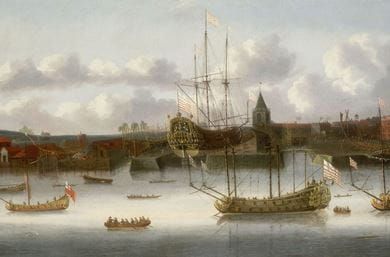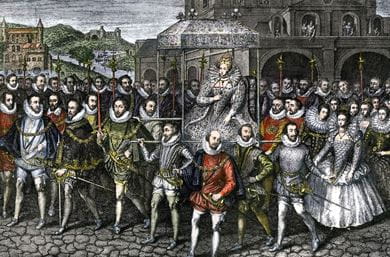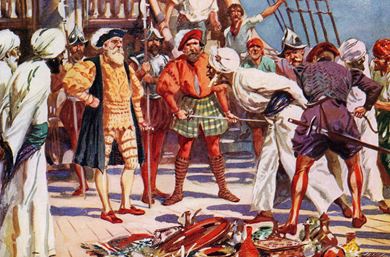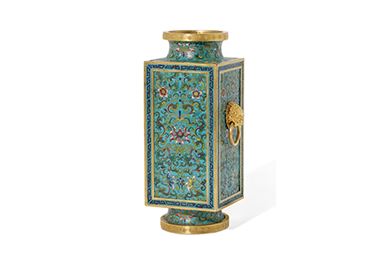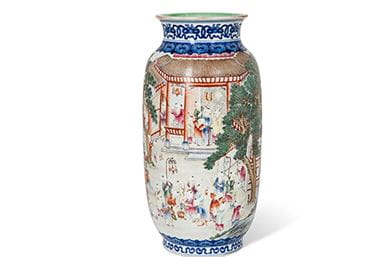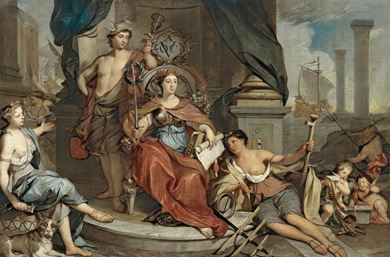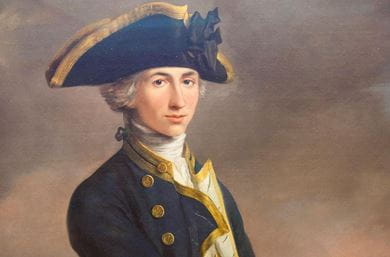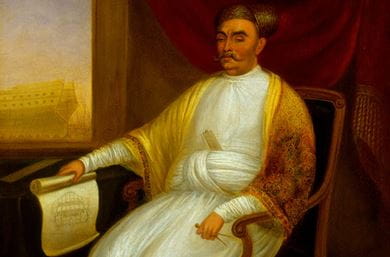






The East India Company was one of the most powerful commercial endeavours the world has ever seen, developing into a huge global corporation
A gallery at London’s Maritime Museum and accompanying book tell the story of how the Company, in pursuit of profit, had significant and long-lasting effects on the lives of millions of people in Asia. As far as Britain was concerned, it fundamentally altered ideas of taste and fashion, introducing pepper, for example, which helped act as a food preservative, and the exciting flavours of spices as well as tea, which proved its greatest success. Luxury goods such as Chinese porcelain became treasured over centuries. Fashionistas were entranced by new fabrics like muslin, calico and of course silk. The Oriental design form of the Arabesque, favoured by the Mughals in India, inspired the still influential Paisley pattern.
In a sense, the Company can be seen as a forerunner of the modern multinational. But for just one company, its global reach was unique, as was its role as a catalyst for the rule of the British Empire in South Asia. At its height, it minted its own currency and ruled over a fifth of humanity. It had its own navy, the Bombay Marine, and a private army of 250,000 soldiers at its command. Despite constant questioning by the British establishment about the propriety of a private commercial company ruling huge swathes of territory and vast numbers of people, rather like the banking scenario today, the Company was regarded as too big to fail. It was repeatedly bailed out, ending its days in controversy and ignominy.
The Portuguese and Dutch led the way eastwards, Vasco da Gama reaching the spice port of Calicut on the Malabar Coast of southwest India in 1498. By the 16th and 17th centuries, the ancient pattern of long-distance overland trade between Asia and Europe, typified by the Silk Route, was completely altered by maritime traffic, expanding dramatically in scale. European demand for high-value Asian goods made fortunes for those who financed the voyages; the captains and even the sailors who returned from these incredibly lengthy and dangerous voyages also expecting to make money.
Since Vasco da Gama’s arrival in India, the Portuguese had successfully captured and controlled a network of ports centred on Goa, monopolising Indian Ocean trade. The English wanted a piece of the action. Harbouring dreams of unlimited riches, a group of traders from the City of London approached Elizabeth I, who in 1600, granted a royal charter to 219 adventurers incorporated as ‘The Governor and Company of Merchants of London Trading into the East Indies’, later known as ‘The East India Company’, giving it a monopoly of all English trade east of the Cape of Good Hope. The first voyage left London in 1601 with a ship armed with over 100 cannon to protect it from pirates, the traditional European foes, and potentially hostile local Asians. After 16 months at sea and the loss of 105 men from scurvy, it eventually reached Sumatra. Here the Sultan permitted the men to trade, but unsurprisingly had no use for the woollen clothes they offered as barter, insisting on silver to pay for their spices. Captains of early voyages quickly realised that cotton bought in India was far more favourably received than wool. Then calling on Java for pepper, the first ship returned with a present for Queen Elizabeth, the sort of diplomatic exchange that was to characterise Asian trade for centuries – until colonisation. On the Company’s sixth voyage, which was to Surat, on the northwest coast of India, the realisation clearly dawned that it was essential to get on with local rulers. Its captain was tasked with establishing trade concessions with the “Great Moghul”, who was presented with English royal letters and “two gold rings set with emeralds”. In the early 17th century, Sir Thomas Roe was appointed as the first ambassador to Mughal India, spending three years at the court of the emperor Jahangir. The English victory over the Portuguese at Surat persuaded Jahangir to grant the East India Company rights to establish trade in India; and in 1613 a permanent English ambassador was established at the court.
From 1606 onwards and as the centuries progressed, the Company’s trade with India became ever more extensive, and as it insisted on maintaining its monopolies, it managed to keep tight control over business. Initially Surat was the hub, and then in 1611 another port system was developed on the eastern Coromandel Coast at Masulipatam in the Kingdom of Golconda, famous for its diamonds. Several other key settlements began to serve as administrative centres, eventually maturing into the ‘presidencies’ of Bombay, Calcutta and Madras. At this time Indian goods became much more prominent in the cargoes sent to London, as opposed to those from further east, especially when pepper began to be obtained from the Malabar coast. The Company first imported cotton fabrics into London in 1613, and by the 1620s, four generic types of fabric arrived on a regular basis: plain white calicoes, single coloured cotton, striped chintzes and the painted cloths known as pintadoes, many from the textile-rich region of Bengal, where another permanent ‘factory’ had been established. Indian silk became the rage among the rich merchants and upper class of England. The Company became acutely responsive to fashion demand – the ‘calico craze’ following hot on the heels of the popularity of muslin. But the most significant development was the trade in tea, at first obtainable via Madras from China, and later, of course, from India itself.
Company voyages to India remained long, arduous and hazardous. In the Company’s early days, some of its ships were very large indeed, but over time, with experience of monsoon conditions and the lack of necessity to carry canons against pirates, ships became smaller. These 500 to 800-ton vessels became known as ‘East Indiamen’. After 1780, when a rapid expansion of the tea trade took place, the Company again began to use larger ships of 1,200 – 1,400 tons.
Ever keen to increase trade and maximise profit, the Company realised that expansion of knowledge about India would be a significant benefit. Some Europeans studied ‘Hindustani’, Persian and Arabic, and in 1734 an English version of the Qur’an was published. Just as East Indiamen brought more English to Asian shores, so Asians began to travel to Europe in increasing numbers, and were generally received with interest and civility. But radical change in Asian-British relationships was on the way. The transition during the 18th century was at first gradual and almost imperceptible. But then, in a sudden, dramatic move, Lord Robert Clive seized power in Bengal in 1757. The Mughal Empire was already in decline, and for whatever reason, its emperor, Shah Alam II, acknowledged Clive’s coup, and even granted him the states of Orissa and Bihar in 1765. The whole Company raison d’être had been fundamentally altered by the acquisition of territory in India. Bringing over a large army, it now not only administered justice, but also governed millions of people. In essence, after 1750 the East India Company became preoccupied with empire, as its military and political influence was extended far across the Indian subcontinent. It took on the trappings of imperial power, building forts, garrisons, courts, administrative buildings and ‘white towns’ in Bombay, Madras and Calcutta. During the late 18th century, one of the most successful challenges to Company power was posed by the sultans of Mysore, fighting four wars over successive generations for control of southern India. In 1780 Tipu Sultan defeated the British at the Battle of Pollilur, killing 3,000 English troops, described at the time as “the severest blow that the English ever sustained in India”. It took a combination of Company and Crown forces to defeat Tipu in 1799.
By 1830 the East India Company was in control of vast swathes of India. But by 833, the Company had lost the last of its trading monopolies to China, ceasing to be a major commercial enterprise. Shorn of its trading function, it now found itself principally responsible for the government of a huge and growing Indian Empire, with no business backup. With hostility to it mounting at home, the great Imperial
Nita Mukesh Ambani Cultural Centre brings to the city a vibrant space for the world of music, dance, ...
I sometimes feel as though the legacy of Lord Kitchener has pursued me all of my life. I studied his ...
In 1992, Prince Charles, the Prince of Wales and heir to the British Throne visited India along with ...
Should one risk a vacation in the middle of pandemic? I thought long and hard about it before decidi ...
The Mona Lisa traces back herself to her artist Leonardo da Vinci’s life at Château du Clos Lucé in ...
The Oberoi Beach Resort, Lombok has undergone rejuvenation and evolved into a destination of unrival ...
A vivid tour through the hottest Bree Street’s central reaches that we call home to the ethical food ...
The Oberoi Beach Resort, Sahl Hasheesh, offers a royal experience amidst the colourful sea life at E ...
Located at the junction of Aravali and Vindhya ranges, Ranthambhore National Park was once a private ...
William Shakespeare lived through one of the most turbulent yet thrilling era’s of English history ...
While central Melbourne has its own allure, the city’s charm lies in its diverse suburbs, each of wh ...
Adrian Rohnfelder, a photographer with a keen interest in volcanoes and adventure, shares his extrao ...
Witness the journey of a wooden instrument that broke all the records to become the backbone of Arab ...
To leap beyond imposed restrictive limits of existence is precisely what Dimpy Menon’s artworks spea ...
More than just a circus, Phare performers use theater, music, dance and modern circus arts to tell u ...
Peru is one of the peak experiences in travel. Nowhere on earth is there such an incredibly wide ran ...
The Oberoi Sukhvilas Spa Resort, New Chandigarh helps you get in touch with yourself so that you liv ...
The establishment of the British Empire greatly influenced the architecture and culture of India an ...
Complete with red sandstone fort, torch lit ramparts and ‘Haveli’ mansions, The Oberoi Rajvilās, Jai ...
Come aboard The Oberoi Zahra, Luxury Nile Cruiser for a delightful mix of luxury and history ...
The incredible Turtle Sanctuary at The Oberoi Beach Resort, Bali, is a must-visit for nature lovers ...
As part of the Beatles, arguably the most iconic rock band of all time, John Lennon and Paul McCartn ...
Oberoi Hotels & Resorts have won the hearts of many with its exquisite charm and glorious stays ...
When I work with a subject, whether it is landscape or nudes, I’m in a relationship with whatever’s ...
Portugal’s capital city of blues from the ubiquitous blue tiling adorning buildings to fado, the sou ...
My conceptual concerts initiate dialogue using various art forms. I wanted to produce works that are ...
From sticky toffee pudding and gastro pubs, to farmers markets, heritage farm meat and stalls housin ...
German art historian Sebastian Schütze, a creative master and precise in technique, captures the hum ...
The Italian art witnessed drastic movements in the period between 1850 to 1950, giving a platform fo ...
All associated with Mughal emperors, maharajas and their courts, the Al Thani Collection is a marvel ...
In the age of art as speculative and subjective, beauty can seem very much beside the point. But sta ...
Complex narratives are the peak of excitement for me. Narratives like double portraits provide stimu ...
At the helm of his eponymous brand, Fendi and Chanel, the late Karl Lagerfeld became as iconic as th ...
Essentially an attempt to replicate a beautiful representation on the canvas, I hope to convey the c ...
The Oberoi, New Delhi’s makeover is an inspiration of the contemporary interpretation of Sir Edward ...
An institution rather than a hotel, the glorious Oberoi Grand, Kolkata is the place tradition calls ...
Ginarte is a journey into beauty, a harmonic synthesis, an expression of strength and delicacy, a hy ...
Oberoi Hotels & Resorts has been ranked the world’s Best Hotel Group at the Telegraph Travel Awards ...
With more than 400 displays, Toward a Concrete Utopia: Architecture in Yugoslavia, 1948–1980, is the ...
Life of the royals in medieval England, especially the queens, was full of intrigue and scandal but ...
The Asian art scene, though young, is booming and art fairs continue to play a significant role in t ...
From ebonised Georgian bracket to 19th-century French brass carriage and the 21st-century Jaeger Le- ...
With more than 400 displays, Toward a Concrete Utopia: Architecture in Yugoslavia, 1948–1980, is the ...
The Oberoi Rajvilas, Jaipur offers an exemplary experience of luxury that transports you to the gold ...
Winner of “Middle East’s Leading Luxury City Hotel” for five consecutive years by the coveted World ...
With elegantly designed villas that offer the best of interiors to its patrons, The Oberoi Beach Res ...
On the north-west coast of Africa lies Casablanca, an ancient exotic land embraced in the sweeping s ...
The new uniforms adorning the staff at The Oberoi, New Delhi are a reflection of The Oberoi Group’s ...
Swan Lake, the iconic ballet composed by Pyotr Ilyich Tchaikovsky in the late 19th century, continue ...
The Buddha, in his many iterations across South Asia, is most exquisitely represented in gilt-bronze ...
At luxury watch brand Carl F Bucherer, design is about bringing together form and function to create ...
Queen, temptress, politician, murderer: Cleopatra remains an object of fascination for writers, arti ...
Go pedal-to-metal with the best track-ready cars unveiled at the 2018 Geneva Motor Show ...
With an enchanting combination of natural splendour, medieval heritage and modern luxury, The Oberoi ...
The Oberoi Udaivilas, Udaipur, brings together the finest in nature, luxury and impeccable service t ...
The Oberoi Amarvilas, Agra, has been voted the Top India Resort Hotel at the Travel + Leisure, USA W ...
Swiss Photographer Christian Tagliavini captures 15th and 16th-century courtly culture in a series o ...
As innovations in air travel bring the UK and Australia closer, the Kangaroo Route – once stretched ...
The Oberoi, Gurgaon offers a traveller more than just the opulence of a five-star hotel: it is a san ...
In the year 1936, legendary artist Henri Matisse executed with the utmost elegance a charcoal portra ...
The elegant suites at The Oberoi, Mumbai, provide an unrivalled experience of The Oberoi Group’s sig ...
The art collection of David and Peggy Rockefeller has garnered the highest total for any private col ...
The Oberoi Philae, Luxury Nile Cruiser takes you through the highlights of the Egyptian river on a s ...
Complementing its signature old-world charm with the finest of contemporary facilities, this Oberoi ...
Truly great experiences in life, are integral to a design sensibility that seeks to create a visual ...
Modern Indian cuisine is coming into its own, with pioneering Indian chefs like Vineet Bhatia, Gagga ...
Sailing along the River Nile aboard The Oberoi Zahra, Nile Cruiser, explore Egypt’s mystical tombs a ...
Late entertainer David Bowie’s art collection, recently auctioned by Sotheby’s, is an eclectic mix o ...
Majestic lions, magnificent wild elephants and an untouched, untainted landscape weaving together na ...
From Jean Paul Gaultier and Christian Dior to Emilio Pucci and Christian Louboutin, international fa ...
world are among the most highly coveted collectible antiques today ...
Home to the perfect confluence of nature and concrete, Al Zorah gives to luxury travellers the getaw ...
An institution rather than a hotel, the glorious Oberoi Grand, Kolkata is the place tradition calls ...
Combine the exhilaration of a jungle adventure with the relaxation of a luxurious retreat at this sp ...
From exotic varieties to beautiful native species, trees can transform your estate into your own sli ...
The East and the West might speak distinct design languages, but bring them together and a spectacul ...
In the land of the midnight sun, a quintessential family vacation is punctuated by a breathtaking ex ...
The misty Wuyi mountains in Fujian, China are home to Da Hong Pao tea, which can sell for more than ...
Award-winning architect Francis Kéré talks about his design journey and giving back to his homeland ...
In Milan, designer Arthur Arbesser and his associates work and play together, perhaps setting a temp ...
Magnates of the luxury world have been taking charitable steps into the world of European applied ar ...
The culinary offerings at The Oberoi Beach Resort, Al Zorah, reflect its vibe of simple sophisticati ...
The works of 18th-century chaser-gilder Pierre Gouthiere stand testimony to the aesthetic opulence o ...
The inner health of an organisation is as important as the external forces that influence its ascent ...
The artistic traditions of mounted porcelain and enamelling lend a whimsical air to some of the most ...
The finest works of literature can sometimes make for the finest works of cinema, and the list of fi ...
The iconic Victorian writer and social critic, seen through the eyes of his great-great-great grandd ...
Be a part of the legacy of turtle conservation on the island of Bali at this luxurious beachside hav ...
With impeccable culinary offerings, Mauritian archaeological heritage and the best location on the i ...
As The Oberoi, New Delhi revels in its newly reopened avatar, take a trip down memory lane and follo ...
Passion, craftsmanship and innovation are the defining aspects of Automobili Lamborghini’s design ae ...
As the universe of food undergoes a rapid transformation across the world, The Oberoi, New Delhi’s a ...
Fashion photography is about more than garments and labels - it is about penetrating the physical fo ...
With an artistic masterpiece by Sir Winston Churchill, The Goldfish Pool at Chartwell, recently goin ...
Balancing modernity with its centuries-old heritage, Amsterdam is a study in splendour and historica ...
Dance does not exist in a box and no rules must necessarily govern it. It is a thing of beauty, myst ...
Nestled within an impregnable valley, the “lost city” of Petra is a spectacular expression of cultur ...
Oberoi Hotels & Resorts has been ranked the world’s Best Hotel Group at the Telegraph Travel Awards ...
Ayurveda, natural healing and mindfulness together create a space of rejuvenation like no other at ...
Beginning in the national capital, make your way through these travel hotspots across India that ref ...
Leonardo da Vinci’s Salvator Mundi claimed a place in auction history recently, setting a new record ...
As the beacon of Western classical music continues to shine bright, a younger generation of musician ...
One fine April morning, 16 actors and technicians set out to take Shakespeare’s Hamlet around the wo ...
From gold snuff boxes inset with diamonds, amethysts and sapphires to ornately enamelled perfume fla ...
The written word, in conjunction with innovations, lies at the very heart of history, shaping cultu ...
August 1947: It had been more than a week since freedom had arrived and the country partitioned. But ...
The Biennale des Antiquaires culminated this year in stunning glory, only to cast its spell afresh n ...
Over the years, I must have observed and recorded the behaviour of at least 125 tigers in Ranthambho ...
The ancient science of Ayurveda tells you how best to enhance your beauty and nourish not only your ...
The gleaming, fluorescent-green topsides of the superyacht Inouï may scream luxury at the Maxi Yacht ...
The world is changing and it is not changing to the benefit of the manufacturers and retailers of so ...
This season, drive in style with these uber-luxurious four-wheeled debutantes ...
The phrase, ‘home is where the heart is’ acquired a new meaning for the children at SOS Children’s V ...
India’s finest private collections of classical Indian art mindfully preserve its creative heritage ...
Make memories last forever by taking your most cherished photographs beyond the frame and photo albu ...
With breathtaking views, luxurious rooms, rejuvenating spa therapies and a state-of-the-art golf cou ...
Seamlessly weaving together traditional elements of Indian architecture, aesthetically landscaped ga ...
Exquisite collectibles going under the hammer are letting connoisseurs acquire a little bit of histo ...
Coming to India in 1865 as the principal of an art school, John Lockwood Kipling made an invaluable ...
When travelling along the path of kings and queens, The Oberoi Hotels & Resorts offer a palatial pla ...
For luxury travellers, the sky is the limit, quite literally, as a gourmet open-air meal at the base ...
From 18th-century ormolu clocks framed by candelabra to enamelled 19th-century timepieces, mantel cl ...
The Emirate of Ajman is home to The Oberoi Beach Resort, Al Zorah, a modern architectural masterpiec ...
The last queen of France was a great commissioner of beautiful things, and several of the shops she ...
From exclusive garments manufactured in Italy to style inspirations drawn from art, this is what the ...
A new facet of Pablo Picasso’s artistic repertoire is taking over the international art market his c ...
Every bottle of vintage wine has a story to tell. We give you the narratives behind five of the fine ...
In the universe of Modern art, rivalry is a complex dynamic that enables one artist to be influenced ...
A story is conditional – it is a matter of perception and might not always be, subliminally or even ...
From unique water and land activities to certified diving courses, desert tours and more, this all-s ...
Enrich your stay in Ranthambhore at this opulent jungle resort, in close proximity to nature, yet ne ...
With performative nuances and provocative appeal, Western classical music has evolved into a complex ...







Second child until maximum age of 12 years will be accommodated in the same room at additional supplement. The additional amount is not included in the room price mentioned and shall be payable at the hotel during check-out.
400 AED (including tax)
250 AED (including tax)

